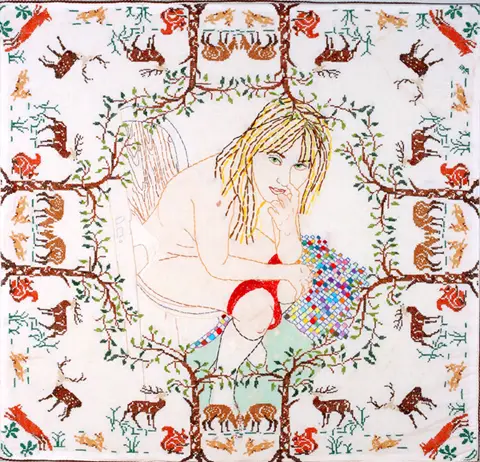
Welcome to ARTeries where we lead you to broader interpretations of “embroidery”. In the dictionary, it’s defined as “Embroidery: the art or handicraft of decorating fabric or other materials with needle and thread or yarn,” but in our lexicon it means everything from “classic” embroidery to art quilting, mixed media, sculpture, book and paper arts, with new methods, old techniques revisited, and the weird and wonderful.
Momma used to buy new clothespins every 2 months. The humidity of an Ontario summer rusted them out pretty fast and gawdz forbid there should be any clothes-pin rust marks on Daddy’s shirts, ghandis or hankies! Anything on that clothesline that dared stain was subjected to a vigorous scrubbing, usually provided by *this* daughter, with lemon juice, baking soda and a stiff brush, and copious amounts of under the breath cursing, then whipped back out on the line in the sun for it to do *its* bleaching part.
Too bad we didn’t know then, and Daddy didn’t appreciate, the artistry that can be created with a few choice pieces of rusted machinery! Adding deliberate rust encrusting to compost dyeing, natural dyeing and ecoprinting can create wonderfully “Complex Cloth”.
Artists of all ilk have added rust technique to their repertoire, producing intricate and unique designs on fabric, plastics, wood and sometimes incorporating the actual rusted object into the finished artwork.
Rust can add intricately detailed or bold areas to cotton, synthetics and, with care, silk, of all kinds. A certain amount of control is possible, but in the end, the chemical reaction has its way and every piece will be distinctive. It colours the cloth, elaborates on weave and stitch, and leaves its own mark within mark. It can accent synthetic and synthetically dyed materials as well, though tests are always a good thing. A good ruster can even have his or her own style, a recognizable element that can’t be copied, due to the response of every artist’s environment to natural forces.
Pat Vivod experiments with combining rusting and ecoprinting, with stunning results in large scale pieces:
This piece above is actually 100 x45 inches! Diminutive careful work can also be seen on her website/blog, “Sentimental Pentimento”.
Kimberly Baxter Packwood is the natural dye science expert I turn to when I have a question about anything I need to know about dyeing in practically any form!
Kimberly can be found on Instagram where she continues her explorations.
Lois Jarvis of Rust-Tex fame can see the image in her rust work:
And adds accenting metal itself:
Rio Wrenn has been rusting fabric since 2001 and creates the most amazing wearable art. Find her on Instagram and you’ll appreciate the breadth of her work even more!
And shibori rusted artwork:
Penny Berens is one of my personal favourites. A sensitive hand with the needle, her hand stitched extravaganzas (see more of them on her Instagram) often include rusted fabrics.
My own work has featured rust also on occasion:
As simple as wrapping an object, spritzing with water and loosely covering with plastic, preferably in the sun to hasten the heat and humidity, or as complex as layouts, “special” vinegar and water recipes and intricate foldings, rusting can create focal areas or enhance other surface design techniques. It can have clear images, muddy detail, distinct composition or a wabi-sabi aesthetic.
By chance, I found this insightful page about rust, methods, concept and development by Canadian artist Wendy Feldberg. There’s a wealth of images, techniques, and how to’s available online about rust and fabrics. Start your search with the above sites, particularly Kimberly and Lois, as they have books and CD’s available.



















